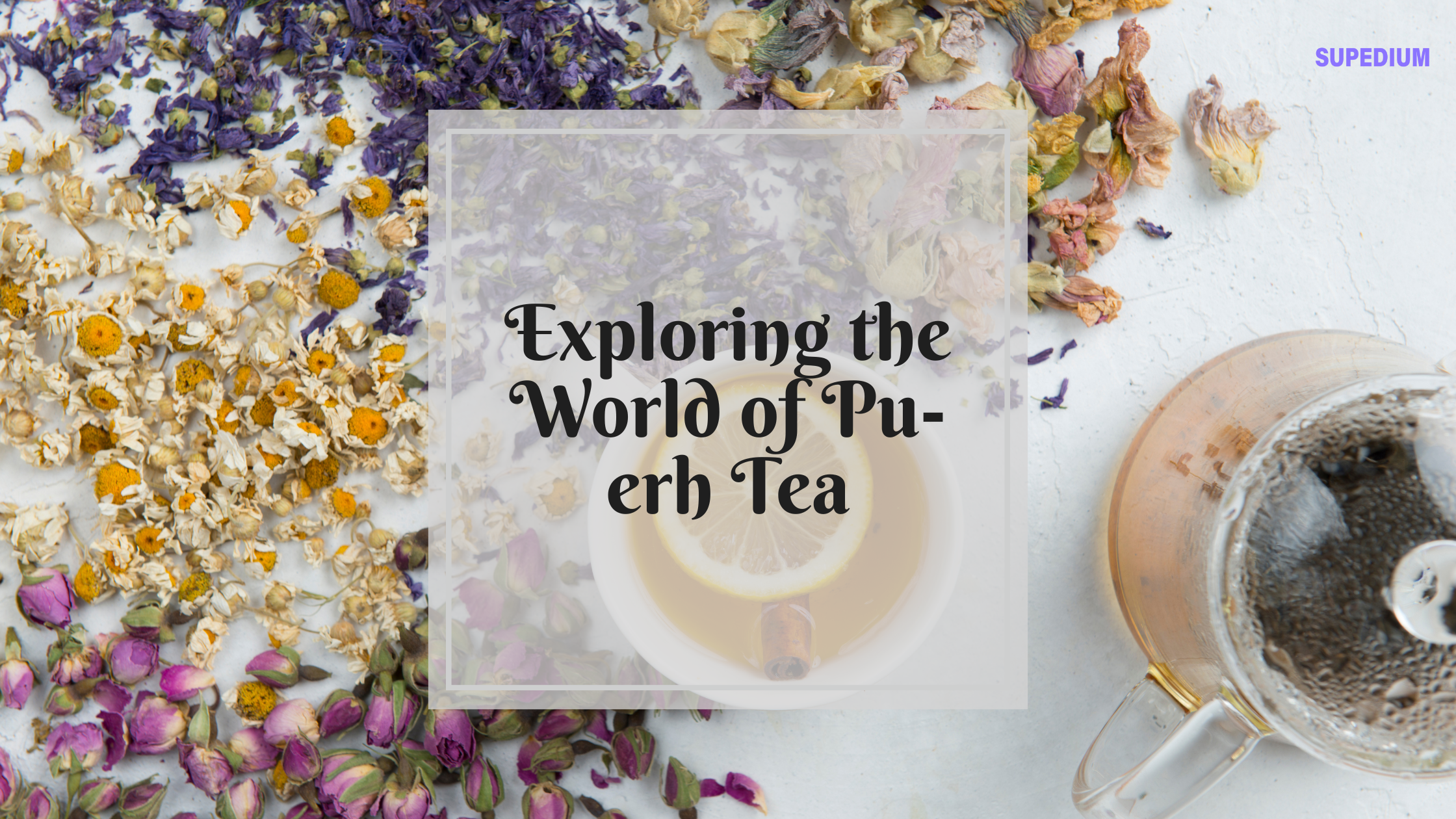Table of Contents
![]()
Introduction
Pu-erh tea is a distinctive and ancient type of fermented tea originating from Yunnan Province in China. Unlike other teas, Pu-erh tea undergoes a unique fermentation process that contributes to its complex flavors and potential health benefits. With a deep-rooted history and a strong cultural significance, Pu-erh tea offers a rich exploration into the world of traditional Chinese tea culture.
History of Pu-erh Tea
Origins and Historical Development
Pu-erh tea’s origins trace back over a millennium, with historical records indicating its production as early as the Tang Dynasty (618–907 AD). Initially, it was a tribute tea for Chinese emperors, highly prized for its unique aging process and health benefits. The tea’s name is derived from Pu’er, a county in Yunnan Province, which became a central trade hub for the tea.
Traditional Production Methods
Historically, Pu-erh tea was processed using methods that involved sun-drying, steaming, and compression into cakes or bricks. This traditional method allowed the tea to be transported over long distances, often by caravan, to reach distant markets. The natural aging process was facilitated by the compressed form, which helped the tea to develop its characteristic flavors over time.
Types of Pu-erh Tea
Raw (Sheng) Pu-erh
Raw Pu-erh, or Sheng Pu-erh, is the traditional form of Pu-erh tea. It is made from freshly picked tea leaves that are withered, steamed, and then pressed into cakes or bricks. Raw Pu-erh undergoes a natural fermentation process over time, which develops its flavor complexity. Initially, Sheng Pu-erh can be quite astringent and grassy, but with aging, it mellows and develops rich, deep flavors with notes of earthiness, sweetness, and sometimes even a hint of floral undertones.
Ripe (Shou) Pu-erh
Ripe Pu-erh, or Shou Pu-erh, was introduced in the 1970s as a way to mimic the aging process of Sheng Pu-erh more quickly. It involves a process called “wo dui,” which accelerates fermentation through controlled microbial activity. This process results in a darker, more mellow tea with a rich, earthy flavor profile and a smoother texture compared to Sheng Pu-erh. Ripe Pu-erh is known for its deep, smooth, and sometimes sweet taste, with a darker liquor color.
Comparison between Raw and Ripe Pu-erh
While both types of Pu-erh tea share the same base ingredient—tea leaves from the Camellia sinensis plant—their production processes lead to distinct differences. Sheng Pu-erh is characterized by its potential for long-term aging and flavor development, while Shou Pu-erh offers a more immediate and consistent flavor experience due to its accelerated fermentation. The choice between Sheng and Shou often comes down to personal preference and desired aging potential.
Production Process
Harvesting
The production of Pu-erh tea begins with the careful selection of tea leaves. The best quality leaves are typically picked from older tea trees, and the timing of the harvest can significantly impact the tea’s flavor profile. The leaves are usually picked in the spring and summer months, when they are most tender and flavorful.
Withering and Wilting
After harvesting, the leaves undergo withering to reduce their moisture content and make them more pliable for further processing. This stage is crucial for developing the initial flavor and aroma of the tea. The withering process is usually done in a well-ventilated area to prevent oxidation.
Shaping and Oxidation
Once the leaves are wilted, they are shaped and undergo oxidation. For Sheng Pu-erh, the leaves are steamed and then pressed into cakes or bricks. For Shou Pu-erh, the leaves undergo a controlled fermentation process involving moisture and heat to accelerate oxidation. This step is essential for developing the tea’s texture and flavor.
Fermentation and Aging
Fermentation is a key stage in Pu-erh tea production. For Sheng Pu-erh, fermentation occurs naturally over time as the tea is aged. Shou Pu-erh, on the other hand, undergoes an accelerated fermentation process that mimics years of natural aging in a shorter period. The conditions under which Pu-erh tea is stored—temperature, humidity, and airflow—play a significant role in its aging process and final flavor profile.
Regions and Varieties
Yunnan Province
Yunnan Province, located in southwestern China, is the birthplace of Pu-erh tea. The province’s diverse climate and soil conditions contribute to the unique characteristics of Pu-erh tea produced there. Major production areas within Yunnan include the regions of Pu’er City, Xishuangbanna, and Lincang. Each region has its own distinct tea varieties and production methods.
Other Notable Regions
While Yunnan remains the primary source of Pu-erh tea, other regions in China and beyond have begun producing Pu-erh-style teas. These include areas in Guangxi and Sichuan provinces, as well as countries like Vietnam and Laos. These regions offer unique variations of Pu-erh, influenced by local growing conditions and production practices.
Tasting and Flavor Profile
Flavor Characteristics
The flavor profile of Pu-erh tea can vary significantly between Raw and Ripe types. Raw Pu-erh is known for its vibrant and complex flavors, which can include notes of earth, wood, and herbs. As it ages, it develops a mellower, smoother taste with rich, nuanced flavors. Ripe Pu-erh, by contrast, tends to have a more consistent flavor profile with earthy, woody, and sometimes sweet notes.
Aging and Flavor Development
Aging is a crucial factor in the development of Pu-erh tea’s flavor. Raw Pu-erh improves with age, gaining complexity and smoothness over time. In contrast, Ripe Pu-erh is designed to be enjoyed relatively young, though it can also benefit from additional aging.
Brewing Techniques
To enjoy Pu-erh tea at its best, it is essential to use proper brewing techniques. For both Raw and Ripe Pu-erh, using a high-quality teapot and precise water temperature is key. Generally, water should be just below boiling, around 200-212°F (93-100°C), and the tea should be steeped for short intervals to avoid bitterness. The amount of tea and steeping time can be adjusted according to personal taste.
Health Benefits
Traditional Beliefs
In traditional Chinese medicine, Pu-erh tea is believed to have various health benefits, including aiding digestion, reducing cholesterol, and promoting overall well-being. It has been consumed for centuries as part of daily life and health practices.
Scientific Research
Recent scientific studies have explored the health benefits of Pu-erh tea. Research suggests that it may have antioxidant properties, help lower cholesterol levels, and support digestive health. However, more research is needed to fully understand and validate these benefits.
Collecting and Storing Pu-erh Tea
Collecting Pu-erh Tea
Collecting Pu-erh tea can be a rewarding hobby, with many enthusiasts seeking out rare and high-quality varieties. When purchasing Pu-erh tea, factors such as the tea’s age, origin, and producer are important considerations. Authenticity and quality can often be verified through reputable tea merchants and tasting events.
Storage Techniques
Proper storage is crucial for preserving and aging Pu-erh tea. Ideal conditions include a cool, dry environment with good airflow. Pu-erh tea should be kept away from strong odors and light to prevent contamination and degradation. Many collectors use specialized storage solutions to maintain the tea’s quality over time.
Pu-erh Tea in the Global Market
Growing Popularity
In recent years, Pu-erh tea has gained international recognition, with increasing interest from tea enthusiasts and collectors around the world. Its unique aging process and complex flavors have made it a sought-after commodity in the global market.
Trade and Economics
The trade of Pu-erh tea involves various stakeholders, including producers, traders, and consumers. The economic impact on Yunnan Province is significant, with Pu-erh tea contributing to the region’s economy and providing livelihoods for many local farmers and artisans.
Cultural Practices and Ceremonies
Traditional Tea Ceremonies
Pu-erh tea plays a role in traditional Chinese tea ceremonies, where it is appreciated for its rich history and complex flavors. These ceremonies often involve meticulous preparation and serving practices that highlight the tea’s unique qualities.
Modern Interpretations
In contemporary settings, Pu-erh tea is enjoyed in a variety of ways, from casual daily consumption to formal tea tastings. Modern tea culture embraces both traditional and innovative approaches to enjoying Pu-erh tea, reflecting its evolving role in global tea culture.
Conclusion
Pu-erh tea offers a fascinating glimpse into the world of traditional Chinese tea with its unique production methods, diverse flavor profiles, and cultural significance. Whether you are a seasoned tea enthusiast or a curious newcomer, exploring Pu-erh tea provides an opportunity to appreciate the depth and complexity of this remarkable beverage. As interest in Pu-erh tea continues to grow, it promises to remain a cherished part of both traditional and modern tea culture.
Share This





Be the first to comment